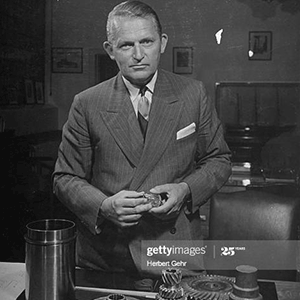 Charles E. Sorensen went with his parents to the USA from Denmark when he was four years old.
Charles E. Sorensen went with his parents to the USA from Denmark when he was four years old.
His first job was at the Buffalo Stove factory, where he trained as a pattern maker and foundry man. His interest in casting was to remain with him all of his life. A firm of custom foundry-men later employed Sorensen in Detroit, where he first met Henry Ford.
The role of the Ford motor company in promoting mass production and assembly line working is well known. However, Ford’s achievements were built on the pioneering work of Sorensen who first had the revolutionary idea of moving the product (in the form of the chassis) through the various workstations. The product was taken to the workers and their tools and equipment rather than the other way round.
Sorensen, along with another Ford manager – Charles Lewis – came in one Sunday and tested his idea for the first time. This was in 1910. Sorensen’s account of his revolutionary development, in his own words:
As may be imagined, the job of putting the car together was a simpler one than handling the materials that had to be brought to it. We gradually worked it out by bringing up what we termed the fast-moving materials. The main bulky parts, like engines and axles, needed a lot of room. To give them that space, we left the smaller, more compact, light handling material in a storage building. Then we arranged with the stock department to bring up at regular hours such divisions of material as we had marked out and packaged. This simplification of handling cleaned things up materially.
But at best, I did not like it. It was then that the idea occurred to me that assembly would be easier, simpler and faster if we moved the chassis along, beginning at one end of the plant with a frame and adding the axles and the wheels; then moving it past the stockroom, instead of moving the stockroom to the chassis. (Ohno, 1988).
Later when the Model T Ford was nearing the end of its commercial life, Henry Ford decided that he wanted to build a V-8-powered car to take its place. Because the company was in a tricky economic position, however, he was forced to first create another four cylinder car, the Model A.
Ford maintained his idea of a V-8, though, and, later – as the Model A also neared its commercial end (1931), Ford engineers embarked on a major development exercise to develop a commercially-viable V-8 engine. At that time, only a few very expensive marques offered eight-cylinder engines, and few of them used Ford’s preferred “V” configuration. Most were based on the much simpler ‘straight-8’ but this was not suitable for a low-priced, short-wheelbase Ford.
The Ford engineering team – Ray Laird, Emil Zoerlein and Carl Schultz – designed a 221 cubic inch powerplant that delivered 65 horsepower at 3400 rpm. Constructed of cast iron with side-operated valves, the engine bas not very sophisticated – but it could be manufactured much more cheaply than the V-8 engines of, say, a Cadillac. It also still offered the smoothness and performance of a ‘real V-8.
The engine still had to go into production. As designed, the 90-degree block at the heart of the engine offered a remarkable degree of sophistication but could still be cast as a single unit. It was Charles Sorensen who worked long and hard on the manufacturing processes necessary to build the new engine. His success led him to being nicknamed “Cast-Iron Charlie”.
During World War 2, Charles Sorensen, then Ford’s Director of Production, conceived the idea of manufacturing the giant B24 Liberator bomber at the unbelievable rate of one an hour. (Previously it was built at the rate of one per day.) The men and women of the Willow Run plant where the bomber was manufactured, challenged by the opportunity and inspired by Sorensens’s vision, actually realised this conception.
Sorensen was Knighted by King Christian of his native Denmark and made a member of the Order of Dannenbrog for his accomplishments in the USA.
Reference:
Ohno, Taiichi (1988). Toyota Production System: Beyond Large-Scale Production. Portland, Oregon: Productivity Press.
